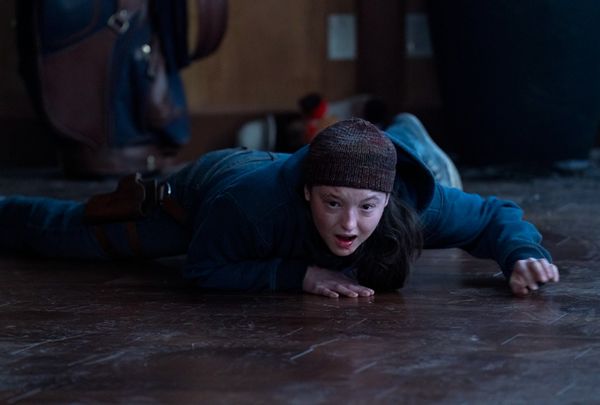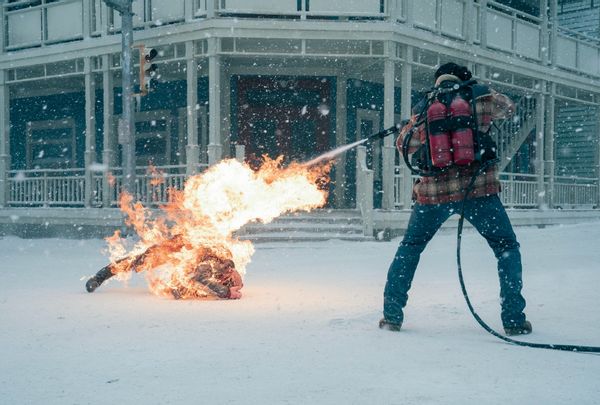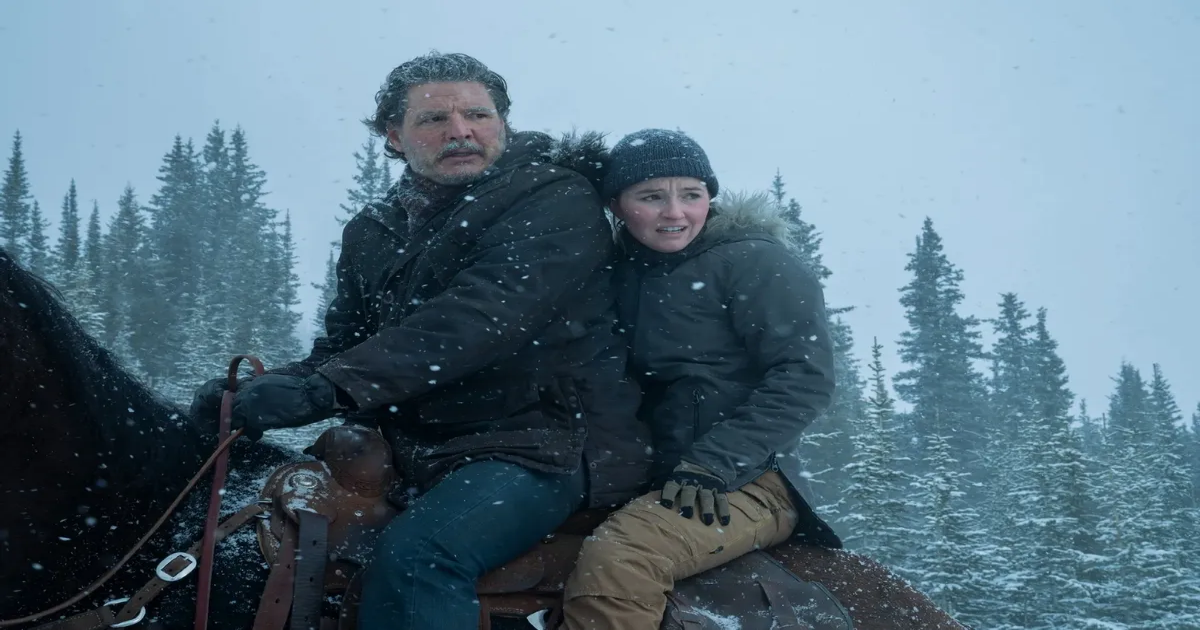HBO’s strained and curious relationship with fathers dates back to 1999, when we witnessed Tony Soprano (James Gandolfini) reconcile his dueling identities of mob boss and family man on “The Sopranos.”
Tony strives to be a present father and dutiful son to a bitter mother he blames for driving away his sainted father Johnny (Joseph Siravo). Only much later do we, and he, come to understand that the absent Soprano progenitor is more to blame for influencing his son’s behavioral shortcomings than Tony first imagines.
Balancing out that darkness is “Six Feet Under” and its genial undertaker, Nathaniel Fisher Sr. (Richard Jenkins), seen in the drama’s opening frames sneaking a smoke while driving to pick up his namesake eldest from the airport.
This places Pedro Pascal’s “The Last of Us” protagonist Joel Miller in a noble crowd of flawed figures whose actions shaped the lives of everyone around them for better or worse. Initially, the emotionally closed-off Joel refuses to treat Ellie (Bella Ramsey), the girl he’s hired to transport across a country teeming with Cordyceps-infected zombies, like anything other than cargo.
Five years after that journey, Joel and Ellie share a house in a safe community. They experience the emotional strain that’s par for the course between a father and a daughter, made more confusing by Joel’s knowing that Ellie isn’t his biological child. But like Nathaniel Sr. and Tony Soprano before him, we watch him come to terms with his mistakes while wondering what it will take for those he loves to forgive him. Sadly, he’ll never receive that answer.
Our memories of the fathers on “The Sopranos” and “Six Feet Under” may have faded under the glaring, angry light of more recent lions. HBO’s current take on patriarchal influence is defined by “Succession” and the cantankerous Logan Roy (Brian Cox), or perhaps “House of the Dragon” and the naïve yet wise Viserys Targaryen (Paddy Considine).
His “Game of Thrones” descendant (or forebear, if we’re following the network’s premiere date chronology), Ned Stark, made more of a mark as the North’s lord paramount. Sean Bean, the actor who plays him, was the show’s biggest star in its first season.
By now, you may recognize the trait these very different figures share. Not only are they all dead, but to a man, those deaths are undignified.
This hero’s death slices Pascal’s protective father typecasting by half.
Logan Roy, one of the richest men on the planet, shuffles off this mortal coil in his private jet’s toilet. Nathaniel Fisher Sr. is driving as he reaches for a cigarette he’d just lied to his wife about smoking, and cruises his car in front of an oncoming bus. The great Viserys rots into shreds of his former self.
Until the events of “Through the Valley,” the second “The Last of Us” episode of Season 2, the Stark paterfamilias’ ignoble demise was the most agonizing turn of all. Honor shapes Ned’s life, one that concludes with him confessing to a crime he didn’t commit before he’s beheaded for the enjoyment of snarling smallfolk he tried to protect.
Joel doesn’t die so publicly or quickly, which would have been a mercy. Neither are we shown the presumed hours his executioner, Abby (Kaitlyn Dever), spends torturing him. But the lasting impact of the blow that kills him, witnessed by a wailing Ellie, is its own dizzying stab of awareness.

Abby and her loyal band of former Fireflies camp out in a mountain lodge near the Jackson, Wyoming fort where Joel lives. They’re at a loss as to how to extract him from the place until Joel delivers himself to them when he and Dina (Isabela Merced) save Abby from both a dangerous winter storm and a ravenous zombie horde.
More galling than that is knowing she accidentally awakens that herd, which chases her at first before pivoting towards Jackson, where tendrils of the mycorrhizal network, unifying whatever passes for the horde’s hive mind, have activated in the town’s sewers.
The town’s battle to survive the zombies’ overpowering assault is the main pulse-pounding action in “Through the Valley,” which, we should note, was directed by “Thrones” veteran Mark Mylod. Many of the townsfolk don’t make it, and their slaughter is but a prelude to Joel surrendering to the slow death Abby promises in the second season premiere. It’s tough to say what’s more heartbreaking — the killing itself, or the way Joel turns to glimpse Jackson burning in the distance before the gruesomeness starts, knowing he can’t do anything to stop it or save Ellie a second time.
Despite myriad examples to the contrary, watching a show’s starring character die suddenly still knocks us sideways. Such moves announce the writers’ ruthlessness when it comes to their heroes, selling the looming possibility that no one is safe in their show, not even the audience’s darlings.
Unlike other dramas, especially another TV zombie blockbuster, Joel’s death isn’t excruciating solely for its cruelty. Leading up to that scene, Ellie strives to establish her own hero identity by training in hand-to-hand combat with men twice her size and sharpening her sniping skills with a long gun. She believes she’s as capable as Joel to confront Cordyceps-infected monsters or undisciplined marauders, enemies she believes she knows.
Joel arrived on TV with an expiration date, as anyone versed in the mythology of “The Last of Us” already knew.
But she’s unprepared to face Abby, a woman driven to avenge the loss of another great man cut down in a senseless murder – one that Joel committed and lied about to Ellie.
Ellie, being the only human immune to Cordyceps’ spores, carries the cure inside her body, specifically, her brain. To obtain a means for a cure, they’d have to remove the spores from there, which would kill her. Nobody tells Joel this before he delivers her to the strangers intending to end her life on an operating table in Salt Lake City. He could have sacrificed Ellie to save the world. Instead, he only did what any of us would do if we’d been tricked into handing over a loved one to their murderers.
 Kaitlyn Dever in “The Last of Us” (Liane Hentscher/HBO). That makes the action sequence showing Joel methodically gunning down armed men and women to retrieve his surrogate daughter thrilling and baleful because we are watching him write a check destined to come due. Between that moment and his last, Joel faces conflicts we don’t know much about, save for the fact that both his adopted daughter and his therapist, Gail (Catherine O’Hara), hate him. Possibly for similar reasons.
Kaitlyn Dever in “The Last of Us” (Liane Hentscher/HBO). That makes the action sequence showing Joel methodically gunning down armed men and women to retrieve his surrogate daughter thrilling and baleful because we are watching him write a check destined to come due. Between that moment and his last, Joel faces conflicts we don’t know much about, save for the fact that both his adopted daughter and his therapist, Gail (Catherine O’Hara), hate him. Possibly for similar reasons.
Abby wants Joel dead because the doctor he shot in the head during his rampage was her father.
If Abby’s motive were unreasonable, we’d view her as a simple villain. (She isn’t, demonstrated in her agreement to sedate Dina instead of making her watch the marathon of agony she inflicts on Joel.) But making the main hero of “The Last of Us” the target of righteous vendetta invites viewers to reckon with the concept of justice long prescribed in Westerns. Joel could have let Abby’s father go. He was, after all, armed with a scalpel while Joel held a loaded gun on him.
Then again, Joel could have let Ellie go and possibly saved the world in that bargain. How would that have been wrong?

Joel’s death is a gruesome finale for a good man cut down by a rage he didn’t realize he sowed with his extreme violence.
But Joel arrived on TV with an expiration date, as anyone versed in the mythology of “The Last of Us” already knew. That video game and “The Last of Us 2” were co-created by Neil Druckmann, who realized its TV adaptation beside fellow series creator Craig Mazin and, as we’ve seen, decided against deviating from the character’s original arc.
Hence, our collective shock may be familiar to those “Last of Us” viewers who read George R.R. Martin’s “A Song of Ice and Fire” novels before watching the “Game of Thrones” episode that sealed Ned’s fate. Comprehending the way Martin set up Ned on the page to be the triumphant hero, only to pull the rug out from under his readers, is one matter. Watching Bean’s dutiful lord be torn apart, body and reputation, by a nest of vipers is an altogether different experience. Don’t TV shows find workarounds for popular characters? All the time. Except when they don’t.
If we shared Ellie’s hope that Joel would stand up and fight after being beaten to ground meat, think of that as a taste of what Joan Didion describes as magical thinking, only in TV terms. In the face of death or afterward, we want to believe in the impossible despite the cruel evidence before us.
Want a daily wrap-up of all the news and commentary Salon has to offer? Subscribe to our morning newsletter, Crash Course.
The passage of great TV characters bequeaths to their survivors, including the audience, a rummage of questions that end up shaping their journey. Certain dad deaths, though tough, leave ponderous messes to straighten. Some are navigable, as we saw in “Six Feet Under.” Others, like Logan Roy’s on “Succession,” lay bare their parental arrogance through the actions of his dull-witted children.
Joel’s death is a gruesome finale for a good man cut down by a rage he didn’t realize he sowed with his extreme violence, the type we’ve been taught in countless movies and series is excusable. Like other prestige dramas‘ unkindest deaths, it may serve a higher purpose.
As Ellie warned when she and Joel walked toward the Salt Lake City hospital where he signed his death sentence, there are no half-measures with this show. That knowledge may turn off those who were only watching for the Pascal-as-daddy factor – a small contingent, I’d wager. The rest may be curious to see what this moment kicks off, lending us a new appreciation for everything walking up to that frigid, terrible peak.
New episodes of “The Last of Us” air 9 p.m. Sundays on HBO and stream on Max.
